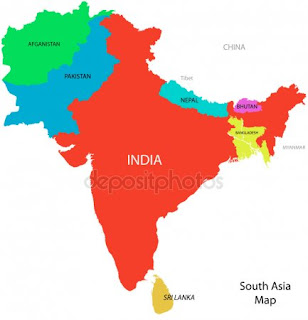stamping of the SAARC Charter in Dhaka on 8 December 1985. There are total 8 Member in Saarc, they are Afghanistan, Maldives, Nepal, Pakistan, Bangladesh, Bhutan, India and Sri Lanka.
About SAARC
the welfare of the social requests of South Asia and to update their own particular
satisfaction; to breath life into cash related headway, social advance and social change in the region additionally, to enable all people to live in respect and to comprehend it their real limits; to advance and support add up to conviction among the nations of South Asia; to add to consistent trust, understanding and valuation for each other's issues; to impel dynamic joint effort and ordinary help with the budgetary, social, social, specific and authentic fields; to support enthusiasm with other making nations; to sustain joint exertion among themselves in overall get-togethers on issues of fundamental interests; and to cooperate with worldwide and regular association with close concentrations and purposes.
READ:
saarc-secretary
about-SAARC
Choices at all levels are to be going up against the start of unanimity, and relating and
opposing issues have avoided the thoughts of the Association.
SAFTA was envisioned on an exceptionally fundamental level as the hidden move towards the change to a South
Asian Free Trade Area (SAFTA) driving in this manner towards a Customs Union, Common
Market and the Economic Union. In 1995, Sixteenth session of the Council of
Pastors (New Delhi, 18– 19 December 1995) concurred on the need to attempt the
confirmation of SAFTA and to this end an Inter-Governmental Expert Group (IGEG) was
set up in 1996 to perceive the key strides for advancing to an unhindered exchange zone.
The Tenth SAARC Summit (Colombo, 29– 31 July 1998) set up a Committee of
Specialists (COE) to draft an expansive game-plan structure for making an energized exchange
zone inside the territory, considering the asymmetries being created
inside the zone and remembering the need to settle sensible and achievable
targets.
The SAFTA Agreement was separate on 6 January 2004 amidst Twelfth SAARC Summit held in
Islamabad, Pakistan. Under this assertion,
SAARC individuals will pass on their responsibilities down to 20 percent by 2009. Following the
Assertion coming into drive the SAFTA Ministerial Council (SMC) has been set up
counting the Commerce Ministers of the Member States.[49] In 2012 the SAARC
passes on stretched out generously to US$354.6 billion from US$206.7 billion of each 2009.
Imports excessively reached out from US$330 billion, making it hard to US$602 billion over an equivalent period.
In any case, the intra-SAARC exchange means just fairly over 1% of SAARC's GDP. In
isolated, in ASEAN (which is greatly littler than SAARC to the degree the level of the
economy) the intra-coalition exchange remains at 10% of its GDP.
SAFTA was envisioned to constantly move towards South Asian Economic Union, in any case, the
current intra-regular exchange and theory affiliation are not empowering and it might
be hard to accomplish this objective. The SAARC intra-regular exchange remains at just
five for every penny on the offer of intra-local exchange general exchange South Asia.
So also, remote direct meander is in like way stunning. The intra-adjacent FDI stream
remains at around four for each penny of the aggregate remote investment.[50]
. Part by segment list
1. Presentation
2. History
3. Objectives
4. SAARC Recognize Bodies
5. Accomplishments and Criticisms of SAARC
. Its part states join Bhutan, India, Nepal, the Maldives, Pakistan and Srilanka, Afganistan, Bangladesh.
. SAARC contains 3% of the universes area, 21% of the universes masses and 3.8% (US$
2.9 trillion) of the general economy, starting in 2015.
2. History of SAARC
a. The probability of close-by interest in South Asia was first mooted in May 1980.
b. The Foreign Secretaries of the seven nations met remarkable for Colombo
in April 1981.
c. SAARC was produced when its assertion was formally affirmed on 8 Dec 1985 by the
head state or Government of 7 countries. Afganistan occupy into a man from SAARC in
April 2007.
d. SAARC has set up persevering imperative relations with the European Union and
Joined Nations as spectators.
e. On 26th and 27th, November 2014 eighteenth SAARC nation pioneers summit was held in the
kathmandu capital of Nepal.
f. Ordinary Centers have been set up in individuals nations keeping in mind the end goal to advance
normal intrigue.
g. Visa disallowance design was developed in the year 1992 by SAARC nations.
3. Targets
a. Proceeding with peace and accomplishment of its part countries.
b. To make economies, add up to trust in the South Asian nations.
c. To set up the social and social change.
4.1 The SAARC Secretariat
a. SAARC was developed in Dhaka on eighth December 1985. the SAARC
b. It Secretariat is orchestrated in Kathmandu, Nepal.
c. It actuated the South Asian Free Trade Area in 2006.
5. Accomplishments and Criticisms
a. As exhibited by the presentation of the sixteenth SAARC Summit (April 2010), SAARCs "scope
in addition, collaboration had extended to orchestrated fields."
b. The level of provincial help in SAARC has expanded, and it has begun
to connect with political, money related, social and particular viewpoints in its discussion.
c. In any case, SAARC is viewed as a disappointment by different investigators. As indicated by onlookers, it
has accomplished adjacent to no" finished the most recent three decades regardless., first India and Pakistan
should base on updating singular ties.



